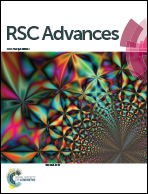A highly selective fluorescent chemosensor based on a quinoline derivative for zinc ions in pure water†
Abstract
A new simple receptor 1 based on quinoline was synthesized as a water-soluble fluorescent ‘turn-on’ chemosensor for zinc ions. In 100% aqueous buffer solution, sensor 1 displayed a selective fluorescence enhancement (317-fold) at 536 nm with Zn2+. The detection limit (4.48 μM) of 1 for Zn2+ was far below the WHO guideline (76 μM) in drinking water. Importantly, sensor 1 could be used to detect and quantify Zn2+ in water samples. Moreover, the sensing ability of 1 for Zn2+ was supported by theoretical calculations. Thus, this sensor 1 has the ability to be a practical system for monitoring Zn2+ concentrations in aqueous samples.


 Please wait while we load your content...
Please wait while we load your content...